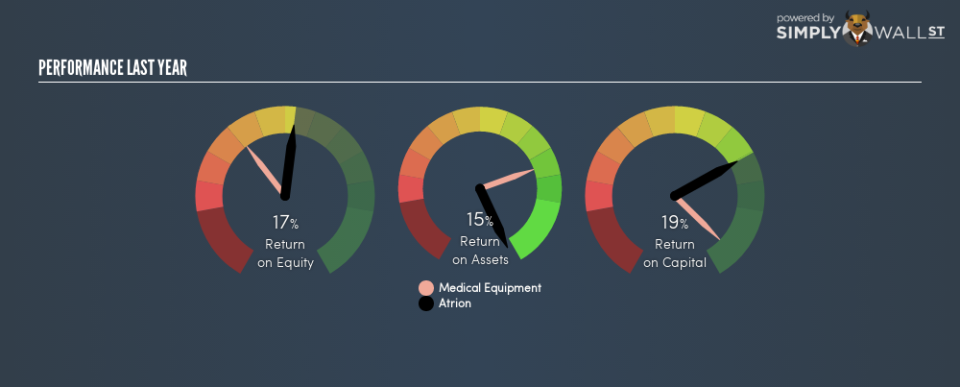Should You Like Atrion Corporation’s (NASDAQ:ATRI) High Return On Capital Employed?

Today we’ll evaluate Atrion Corporation (NASDAQ:ATRI) to determine whether it could have potential as an investment idea. To be precise, we’ll consider its Return On Capital Employed (ROCE), as that will inform our view of the quality of the business.
First up, we’ll look at what ROCE is and how we calculate it. Then we’ll compare its ROCE to similar companies. Finally, we’ll look at how its current liabilities affect its ROCE.
Return On Capital Employed (ROCE): What is it?
ROCE is a metric for evaluating how much pre-tax income (in percentage terms) a company earns on the capital invested in its business. Generally speaking a higher ROCE is better. In brief, it is a useful tool, but it is not without drawbacks. Renowned investment researcher Michael Mauboussin has suggested that a high ROCE can indicate that ‘one dollar invested in the company generates value of more than one dollar’.
So, How Do We Calculate ROCE?
Analysts use this formula to calculate return on capital employed:
Return on Capital Employed = Earnings Before Interest and Tax (EBIT) ÷ (Total Assets – Current Liabilities)
Or for Atrion:
0.19 = US$41m ÷ (US$228m – US$12m) (Based on the trailing twelve months to September 2018.)
So, Atrion has an ROCE of 19%.
View our latest analysis for Atrion
Want to help shape the future of investing tools and platforms? Take the survey and be part of one of the most advanced studies of stock market investors to date.
Is Atrion’s ROCE Good?
When making comparisons between similar businesses, investors may find ROCE useful. Using our data, we find that Atrion’s ROCE is meaningfully better than the 11% average in the Medical Equipment industry. We would consider this a positive, as it suggests it is using capital more effectively than other similar companies. Regardless of where Atrion sits next to its industry, its ROCE in absolute terms appears satisfactory, and this company could be worth a closer look.
As we can see, Atrion currently has an ROCE of 19%, less than the 28% it reported 3 years ago. So investors might consider if it has had issues recently.
It is important to remember that ROCE shows past performance, and is not necessarily predictive. Companies in cyclical industries can be difficult to understand using ROCE, as returns typically look high during boom times, and low during busts. This is because ROCE only looks at one year, instead of considering returns across a whole cycle. If Atrion is cyclical, it could make sense to check out this free graph of past earnings, revenue and cash flow.
What Are Current Liabilities, And How Do They Affect Atrion’s ROCE?
Short term (or current) liabilities, are things like supplier invoices, overdrafts, or tax bills that need to be paid within 12 months. Due to the way ROCE is calculated, a high level of current liabilities makes a company look as though it has less capital employed, and thus can (sometimes unfairly) boost the ROCE. To check the impact of this, we calculate if a company has high current liabilities relative to its total assets.
Atrion has total assets of US$228m and current liabilities of US$12m. As a result, its current liabilities are equal to approximately 5.3% of its total assets. In addition to low current liabilities (making a negligible impact on ROCE), Atrion earns a sound return on capital employed.
What We Can Learn From Atrion’s ROCE
This is good to see, and while better prospects may exist, Atrion seems worth researching further. Of course, you might find a fantastic investment by looking at a few good candidates. So take a peek at this free list of companies with modest (or no) debt, trading on a P/E below 20.
If you like to buy stocks alongside management, then you might just love this free list of companies. (Hint: insiders have been buying them).
To help readers see past the short term volatility of the financial market, we aim to bring you a long-term focused research analysis purely driven by fundamental data. Note that our analysis does not factor in the latest price-sensitive company announcements.
The author is an independent contributor and at the time of publication had no position in the stocks mentioned. For errors that warrant correction please contact the editor at editorial-team@simplywallst.com.

